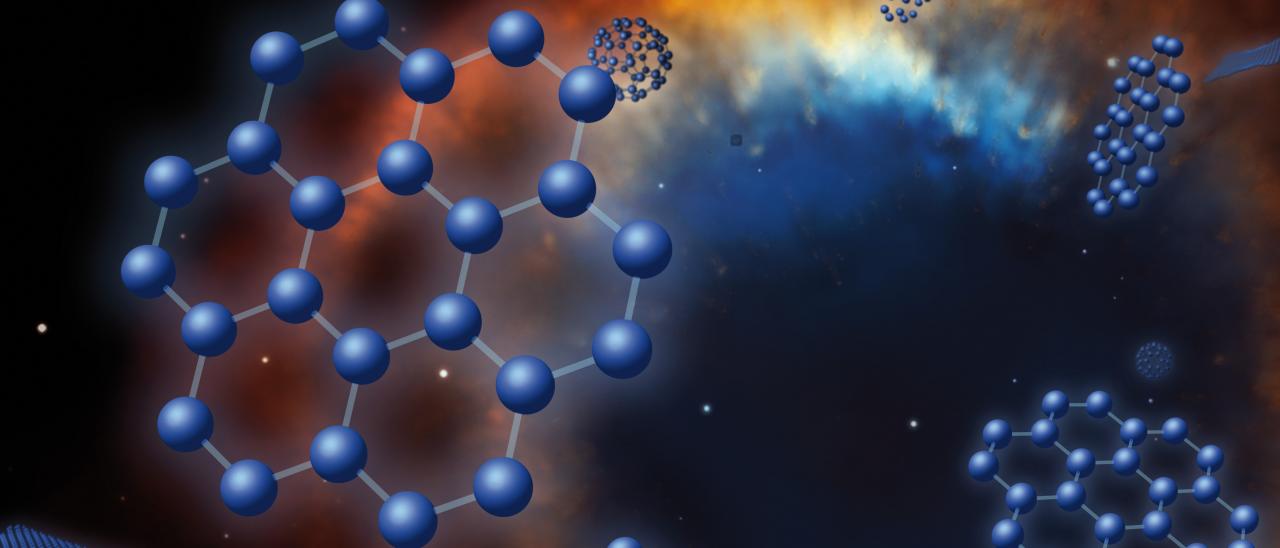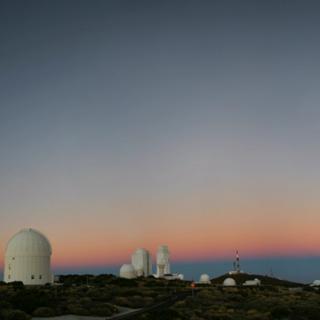Subvenciones relacionadas:
General
Las estrellas de masa baja e intermedia (M < 8 masas solares, Ms) representan la mayoría de estrellas en el Cosmos y terminan sus vidas en la Rama Asintótica de las Gigantes (AGB) - justo antes de formar Nebulosas Planetarias (NPs) - cuando experimentan procesos nucleosintéticos y moleculares complejos. Las estrellas AGB son importantes contribuyentes al enriquecimiento del medio interestelar, donde nacen nuevas estrellas y planetas (incluyendo nuestro propio Sistema Solar Temprano, SST) y a la evolución química de sistemas estelares como cúmulos globulares (CGs) y galaxias. En particular, las AGBs más masivas (M > 4-5 Ms) sintetizan (radio)isótopos muy diferentes de los formados por AGBs menos masivas y explosiones de Supernova debido a los diferentes mecanismos de nucleosíntesis. Las estrellas evolucionadas en la fase de transición entre AGBs y NPs también forman diversos compuestos orgánicos como PAHs y nanoestructuras moleculares de fullereno y grafeno, siendo un maravilloso laboratorio Astroquímico. Colaboraciones astronómicas punteras como SDSS-IV/APOGEE-2 y el próximo telescopio espacial James Webb representan un paso fundamental para entender la nucleosíntesis y los procesos moleculares en estrellas evolucionadas. Se pretende explorar la nucleosíntesis de (radio)isótopos ligeros/pesados en estrellas AGB y como éstas contribuyen a la radioactividad del SST así como a la formación/evolución de CGs y galaxias. También se pretende entender el proceso de formación "top-down" de nanoestructuras moleculares de fullereno y grafeno en estrellas evolucionadas. Finalmente, se pretende realizar minería de datos obtenidos con el satélite Gaia, para estudiar la fase evolutiva AGB-NP, y además utilizar el telescopio espacial GALEX para descubrir estrellas binarias en NPs Galácticas.
Miembros
Resultados
1. Durante 2020, se han publicado 37 artículos en revistas astronómicas internacionales con referee de alto impacto (incluyendo un review invitado), así como 2 artículos en la revista de Química-Física FNCN.
2. Se han descubierto, por primera vez, estrellas muy ricas en fósforo y cuyo patrón químico no es predicho por ninguna teoría actual de nucleosíntesis estelar.
3. Se ha demostrado que las estrellas ricas en fósforo representan un nuevo sitio estelar para la formación de elementos muy pesados, con importantes implicaciones para la evolución química de nuestra Galaxia.
Actividad científica
Publicaciones relacionadas
-
Age-resolved chemistry of red giants in the solar neighbourhood
In the age of high-resolution spectroscopic stellar surveys of the Milky Way, the number of stars with detailed abundances of multiple elements is rapidly increasing. These elemental abundances are directly influenced by the evolutionary history of the Galaxy, but this can be difficult to interpret without an absolute timeline of the abundance
Feuillet, D. K. et al.Fecha de publicación:
62018 -
The Fourteenth Data Release of the Sloan Digital Sky Survey: First Spectroscopic Data from the Extended Baryon Oscillation Spectroscopic Survey and from the Second Phase of the Apache Point Observatory Galactic Evolution Experiment
The fourth generation of the Sloan Digital Sky Survey (SDSS-IV) has been in operation since 2014 July. This paper describes the second data release from this phase, and the 14th from SDSS overall (making this Data Release Fourteen or DR14). This release makes the data taken by SDSS-IV in its first two years of operation (2014–2016 July) public
Abolfathi, B. et al.Fecha de publicación:
42018 -
Heavy-element yields and abundances of asymptotic giant branch models with a Small Magellanic Cloud metallicity
We present new theoretical stellar yields and surface abundances for asymptotic giant branch (AGB) models with a metallicity appropriate for stars in the Small Magellanic Cloud (SMC, Z = 0.0028, [Fe/H] ≈ -0.7). New evolutionary sequences and post-processing nucleosynthesis results are presented for initial masses between 1 and 7 M⊙, where the 7 M⊙
Karakas, A. I. et al.Fecha de publicación:
62018 -
Magnesium isotopes: a tool to understand self-enrichment in globular clusters
A critical issue in the asymptotic giant branch (AGB) self-enrichment scenario for the formation of multiple populations in globular clusters (GCs) is the inability to reproduce the magnesium isotopic ratios, despite the model in principle can account for the depletion of magnesium. In this work, we analyse how the uncertainties on the various p
Ventura, P. et al.Fecha de publicación:
62018 -
Chemical Abundances of Main-sequence, Turnoff, Subgiant, and Red Giant Stars from APOGEE Spectra. I. Signatures of Diffusion in the Open Cluster M67
Detailed chemical abundance distributions for 14 elements are derived for eight high-probability stellar members of the solar metallicity old open cluster M67 with an age of ∼4 Gyr. The eight stars consist of four pairs, with each pair occupying a distinct phase of stellar evolution: two G dwarfs, two turnoff stars, two G subgiants, and two red
Souto, D. et al.Fecha de publicación:
42018 -
StarHorse: a Bayesian tool for determining stellar masses, ages, distances, and extinctions for field stars
Understanding the formation and evolution of our Galaxy requires accurate distances, ages, and chemistry for large populations of field stars. Here, we present several updates to our spectrophotometric distance code, which can now also be used to estimate ages, masses, and extinctions for individual stars. Given a set of measured spectrophotometric
Queiroz, A. B. A. et al.Fecha de publicación:
52018 -
The Metal-poor non-Sagittarius (?) Globular Cluster NGC 5053: Orbit and Mg, Al, and Si Abundances
Metal-poor globular clusters (GCs) exhibit intriguing Al–Mg anti-correlations and possible Si–Al correlations, which are important clues to decipher the multiple-population phenomenon. NGC 5053 is one of the most metal-poor GCs in the nearby universe and has been suggested to be associated with the Sagittarius (Sgr) dwarf galaxy, due to its
Tang, B. et al.Fecha de publicación:
32018 -
Massive Stars in the SDSS-IV/APOGEE SURVEY. I. OB Stars
In this work, we make use of DR14 APOGEE spectroscopic data to study a sample of 92 known OB stars. We developed a near-infrared semi-empirical spectral classification method that was successfully used in case of four new exemplars, previously classified as later B-type stars. Our results agree well with those determined independently from ECHELLE
Roman-Lopes, A. et al.Fecha de publicación:
32018 -
GTC/CanariCam Mid-IR Imaging of the Fullerene-rich Planetary Nebula IC 418: Searching for the Spatial Distribution of Fullerene-like Molecules
We present seeing-limited narrow-band mid-IR GTC/CanariCam images of the spatially extended fullerene-containing planetary nebula (PN) IC 418. The narrow-band images cover the C60 fullerene band at 17.4 μm, the polycyclic aromatic hydrocarbon like (PAH-like) feature at 11.3 μm, the broad 9–13 μm feature, and their adjacent continua at 9.8 and 20.5
Díaz-Luis, J. J. et al.Fecha de publicación:
32018 -
A view of the H-band light-element chemical patterns in globular clusters under the AGB self-enrichment scenario
We discuss the self-enrichment scenario by asymptotic giant branch (AGB) stars for the formation of multiple populations in globular clusters (GCs) by analysing data set of giant stars observed in nine Galactic GCs, covering a wide range of metallicities and for which the simultaneous measurements of C, N, O, Mg, Al, and Si are available. To this
Dell'Agli, F. et al.Fecha de publicación:
42018 -
Submerged carbon arc in liquid benzene: GC-MS analysis of the products
Not Available
Cataldo, Franco et al.Fecha de publicación:
102017 -
Gas and dust from solar metallicity AGB stars
We study the asymptotic giant branch (AGB) evolution of stars with masses between 1 M⊙and8.5 M⊙. We focus on stars with a solar chemical composition, which allows us to interpret evolved stars in the Galaxy. We present a detailed comparison with models of the same chemistry, calculated with a different evolution code and based on a different set of
Ventura, P. et al.Fecha de publicación:
42018 -
280 one-opposition near-Earth asteroids recovered by the EURONEAR with the Isaac Newton Telescope
Context. One-opposition near-Earth asteroids (NEAs) are growing in number, and they must be recovered to prevent loss and mismatch risk, and to improve their orbits, as they are likely to be too faint for detection in shallow surveys at future apparitions. Aims: We aimed to recover more than half of the one-opposition NEAs recommended for
Vaduvescu, O. et al.Fecha de publicación:
12018 -
A photometric study of globular clusters observed by the APOGEE survey
In this paper, we describe the photometric and spectroscopic properties of multiple populations in seven northern globular clusters. In this study, we employ precise ground-based photometry from the private collection of Stetson, space photometry from the Hubble Space Telescope (HST), literature abundances of Na and O, and Apache Point Observatory
Mészáros, Sz. et al.Fecha de publicación:
42018 -
Disentangling the Galactic Halo with APOGEE. I. Chemical and Kinematical Investigation of Distinct Metal-poor Populations
We find two chemically distinct populations separated relatively cleanly in the [Fe/H]–[Mg/Fe] plane, but also distinguished in other chemical planes, among metal-poor stars (primarily with metallicities [{Fe}/{{H}}]< -0.9) observed by the Apache Point Observatory Galactic Evolution Experiment (APOGEE) and analyzed for Data Release 13 (DR13) of the
Hayes, C. R. et al.Fecha de publicación:
12018 -
Disentangling the Galactic Halo with APOGEE. II. Chemical and Star Formation Histories for the Two Distinct Populations
The formation processes that led to the current Galactic stellar halo are still under debate. Previous studies have provided evidence for different stellar populations in terms of elemental abundances and kinematics, pointing to different chemical and star formation histories (SFHs). In the present work, we explore, over a broader range in
Fernández-Alvar, E. et al.Fecha de publicación:
12018 -
Binary stars in the Galactic thick disc
The combination of asteroseismologically measured masses with abundances from detailed analyses of stellar atmospheres challenges our fundamental knowledge of stars and our ability to model them. Ancient red-giant stars in the Galactic thick disc are proving to be most troublesome in this regard. They are older than 5 Gyr, a lifetime corresponding
Izzard, R. G. et al.Fecha de publicación:
12018 -
Elemental Abundances of Kepler Objects of Interest in APOGEE. I. Two Distinct Orbital Period Regimes Inferred from Host Star Iron Abundances
The Apache Point Observatory Galactic Evolution Experiment (APOGEE) has observed ∼600 transiting exoplanets and exoplanet candidates from Kepler (Kepler Objects of Interest, KOIs), most with ≥18 epochs. The combined multi-epoch spectra are of high signal-to-noise ratio (typically ≥100) and yield precise stellar parameters and chemical abundances
Wilson, R. F. et al.Fecha de publicación:
22018 -
C/O ratios in planetary nebulae with dual-dust chemistry from faint optical recombination lines
We present deep high-resolution (R ˜ 15 000) and high-quality UVES optical spectrophotometry of nine planetary nebulae with dual-dust chemistry. We compute physical conditions from several diagnostics. Ionic abundances for a large number of ions of N, O, Ne, S, Cl, Ar, K, Fe and Kr are derived from collisionally excited lines. Elemental abundances
García-Rojas, J. et al.Fecha de publicación:
22018 -
Where does galactic dust come from?
Here we investigate the origin of the dust mass (Mdust) observed in the Milky Way (MW) and of dust scaling relations found in a sample of local galaxies from the DGS and KINGFISH surveys. To this aim, we model dust production from Asymptotic Giant Branch (AGB) stars and supernovae (SNe) in simulated galaxies forming along the assembly of a MW-like
Ginolfi, M. et al.Fecha de publicación:
22018



![Teacup en [O III] y CO(2-1) Los agujeros negros supermasivos modifican la distribución de gas molecular en la región central de las galaxias. Crédito: HST y C. Ramos Almeida.](/sites/default/files/styles/crop_square_2_2_to_320px/public/images/project/teacup_english.001.jpeg?itok=dF4bDw-q)